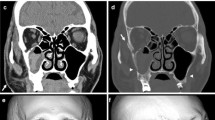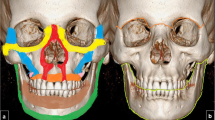Abstract
The aim of this study is to assess multidetector computed tomography (MDCT) findings of facial trauma due to a falling accident. Using picture-archiving and communications system, we retrieved all MDCT requests for suspected facial injury during a 62-month period. Images were interpreted by two researchers. Five hundred patients met the inclusion criteria and 329 (66%) had a total of 515 fractures. Falls on stairs were seen in 109 (22%) patients and slips or trips in 391 (78%). The corresponding number of fractures was 169 (33%) and 346 (67%). Males (N = 241) had more fractures than females (N = 259), 327 vs. 188, respectively. The zygomatic complex was the most common fracture, seen in 40% of patients suffering a fracture. Twenty patients (4%) had fractures involving the sinus walls without paranasal sinus effusions. Facial fractures due to falls are common. The zygomatic complex is the most common fracture. A clear sinus sign may be less reliable than previously thought.






Similar content being viewed by others
References
Tinetti ME (1994) Prevention of falls and fall injuries in elderly persons: a research agenda. Prev Med 23:756–762, DOI 10.1006/pmed.1994.1130
Lehtola S, Koistinen P, Luukinen H (2006) Falls and injurious falls late in home-dwelling life. Arch Gerontol Geriatr 42:217–224, DOI 10.1016/j.archger.2005.07.002
Bloem BR, Steijns JAG, Smits-Engelsman BC (2003) An update on falls. Curr Opin Neurol 16:15–26
Linnau KF, Stanley RB Jr, Hallam DK, Gross JA, Mann FA (2003) Imaging of high-energy midfacial trauma: what the surgeon needs to know. Eur J Radiol 48:17–32, DOI 10.1016/S0720-048X(03)00205-5
Novelline RA, Rhea JT, Rao PM, Stuk JL (1999) State of art: helical CT in emergency radiology. Radiology 213:321–339
Linsenmaier U, Krötz M, Häuser H, Rock C, Rieger J, Bohndorf K, Pfeifer KJ, Reiser M (2002) Whole-body computed tomography in polytrauma: techniques and management. Eur Radiol 12:1728–1740, DOI 10.1007/s00330-001-1225-x
Salonen EM, Koivikko MP, Koskinen SK (2007) Multidetector computed tomography imaging of facial trauma in accidental falls from heights. Acta Radiol 48:449–455, DOI 10.1080/02841850701199959
Manolidis S (2004) Frontal sinus injuries: associated injuries and surgical management of 93 patients. J Oral Maxillofac Surg 62:882–891, DOI 10.1016/j.joms.2003.04.020
Lambert DM, Mirvis SE, Shanmuganathan K, Tilghman DL (1997) Computed tomography exclusion of osseous paranasal sinus injury in blunt trauma patients: the “clear sinus” sign. J Oral Maxillofac Surg 55:1207–1210, DOI 10.1016/S0278-2391(97)90167-1
Campbell AJ, Robertson MC (2006) Implementation of multifactorial interventions for fall and fracture prevention. Age Ageing 35-S2:60–64, DOI 10.1093/ageing/afl089
Iida S, Hassfeld S, Reuther T, Schweigert H-G, Haag C, Klein J, Mühling J (2003) Maxillofacial fractures resulting from falls. J Craniomaxillofac Surg 31:278–283, DOI 10.1016/S1010-5182(03)00069-6
Parizel PM, Van Goethem JW, Özsarlak Ö, Maes M, Phillips CD (2005) New developments in the neuroradiological diagnosis of craniocerebral trauma. Eur Radiol 15:569–581, DOI 10.1007/s00330-004-2558-z
Bassim MK, Ebert CS, Sit RC, Senior BA (2005) Radiation dose to the eyes and parotids during CT of the sinuses. Otolaryngol Head Neck Surg 133:531–533, DOI 10.1016/j.otohns.2005.06.018
Brem MH, Zamani AA, Riva R, Zou KH, Rumboldt Z, Hennig FF, Kikinis R, Norbash AM, Schoepf UJ (2007) Multidetector CT of the paranasal sinus: potential for radiation dose reduction. Radiology 243:847–852, DOI 10.1148/radiol.2433050207
Hein E, Rogalla P, Klingebiel R, Hamm B (2002) Low-dose CT of the paranasal sinuses with eye lens protection: effect on image quality and radiation dose. Eur Radiol 12:1639–1696, DOI 10.1007/s00330-001-1279-9
Aitasalo K, Lehtinen R, Valkama H, Laurikainen E (1996) Väkivalta syynä kolmasosaan kasvomurtumista Lounais-Suomessa vuosina 1985–1989. Suom Lääkäril 51:669
Kontio R, Suuronen R, Ponkkonen H, Lindqvist C, Laine P (2005) Have the causes of maxillofacial fractures changed over the last 16 years in Finland? An epidemiological study of 725 fractures. Dent Traumatol 21:14–19, DOI 10.1111/j.1600-9657.2004.00262.x
Kennedy RL, Grant PT, Blackwell D (2001) Low-impact falls: demands on a system of trauma management, prediction of outcome, and influence of comorbidities. J Trauma 51:717–724
American Geriatrics Society, British Geriatrics Society, American Academy of Orthopaedic Surgeons Panel on Falls Prevention (2001) Guideline for the prevention of falls in older persons. J Am Geriatr Soc 49:664–672, DOI 10.1046/j.1532-5415.2001.49115.x
Koski K, Luukinen H, Laippala P, Kivelä S-L (1996) Physiological factors and medications as predictors of injurious falls by elderly people: a prospective population-based study. Age Ageing 25:29–38
Schillings AM, Mulder Th, Duysens J (2005) Stumbling over obstacles in older adults compared to young adults. J Neurophysiol 94:1158–1168, DOI 10.1152/jn.00396.2004
Cumming RG (1998) Epidemiology of medication-related falls and fractures in the elderly. Drugs Aging 12:43–53
Kurzthaler I, Wambacher M, Golser K, Sperner G, Sperner-Unterweger B, Haidekker A, Pavlic M, Kemmler G, Fleischhacker WW (2005) Alcohol and benzodiazepines in falls: an epidemiological view. Drug Alcohol Depend 79:225–230, DOI 10.1016/j.drugalcdep.2005.01.012
Kanis JA, Johansson H, Johnell O, Oden A, De Laet C, Eisman JA, Pols H, Tenenhouse A (2005) Alcohol intake as a risk factor for fracture. Osteoporos Int 16:737–742, DOI 10.1007/s00198-004-1734-y
Watt K, Purdie DM, Roche AM, McClure RJ (2005) The relationship between acute alcohol consumption and consequent injury type. Alcohol Alcohol 40:263–268, DOI 10.1093/alcalc/agh164
Gerdhem P, Ringsberg KAM, Åkesson K, Obrant KJ (2005) Clinical history and biologic age predicted falls better than objective functional tests. J Clin Epidemiol 58:226–232, DOI 10.1016/j.jclinepi.2004.06.013
Author information
Authors and Affiliations
Corresponding author
Rights and permissions
About this article
Cite this article
Salonen, E.M., Koivikko, M.P. & Koskinen, S.K. Acute facial trauma in falling accidents: MDCT analysis of 500 patients. Emerg Radiol 15, 241–247 (2008). https://doi.org/10.1007/s10140-008-0717-2
Received:
Accepted:
Published:
Issue Date:
DOI: https://doi.org/10.1007/s10140-008-0717-2




